
Executive Summary: The cloud storage market is estimated to be worth over $70 billion as of 2021. It is still fast growing, thanks to its convenience and cost-effectiveness.
Decentralized storage, based on distributed blockchain networks, has emerged as a promising alternative to traditional centralized storage systems, offering users increased security, privacy, and resilience.
However, more is needed to disrupt the already flourishing centralized storage industry. Some projects, such as Filecoin, Sia, and Ocean Protocol, are working to make decentralized storage the go-to choice for consumers and enterprises.
Traditional centralized storage services — such as Amazon, Microsoft, and data centers like Equinix and Digital Realty — have dominated the data storage market for years. They maintain their advantage by providing users with easy access to storage and backup services.
However, as data privacy and security concerns continue to mount, decentralized storage solutions offer users lower prices, more security, and greater control over their data. Below we’ll cover the most significant players and investment opportunities in the space.
Industry Overview
Centralized storage systems have been the backbone of data storage and management for decades. However, as the internet has evolved, so have the risks associated with these storage platforms, including:
- Predatory pricing
- Lack of control over data
- Data mismanagement
- Lack of transparency in pricing
Enter decentralized storage protocols. These projects are trying to rival (and potentially replace) centralized storage companies by creating systems for storing and accessing data, distributed across a network of nodes rather than being centrally controlled by a single entity or organization.
One of the main selling points of decentralized storage protocols is that, by design, they are more resistant to censorship and control by any single authority. In a decentralized system, there is no single point of failure or control, so it is much harder for any entity to shut down or manipulate the system. Plus, decentralized systems are much more secure compared with centralized ones since data is distributed across many nodes, making it much harder for an attacker to compromise the entire system. The data itself is protected through encryption and fragmentation, meaning any individual node sees only “noise” in the data.
Most of these projects have been around for a while, but didn’t receive much attention before 2021. According to a report by CoinGecko, decentralized storage capacity increased by more than 4X from 2020 after hitting 16.7 million TB in storage by the end of 2021. Notably, Filecoin has been leading the pack through the years and currently has the largest capacity, with a network storage power of over 22.4 million TB. However, CoinGecko notes that as of late 2022, only 1% of Filecoin’s total capacity was actively used.

Also, as expected, centralized cloud storage services like Amazon Web Services, Oracle, and Dropbox are still far ahead in revenues generated compared to decentralized storage protocols. This is because these centralized services have been established for a longer time and have a larger customer base, with many large corporations and organizations relying on their services. Decentralized storage protocols, on the other hand, are still relatively new and are struggling with adoption.
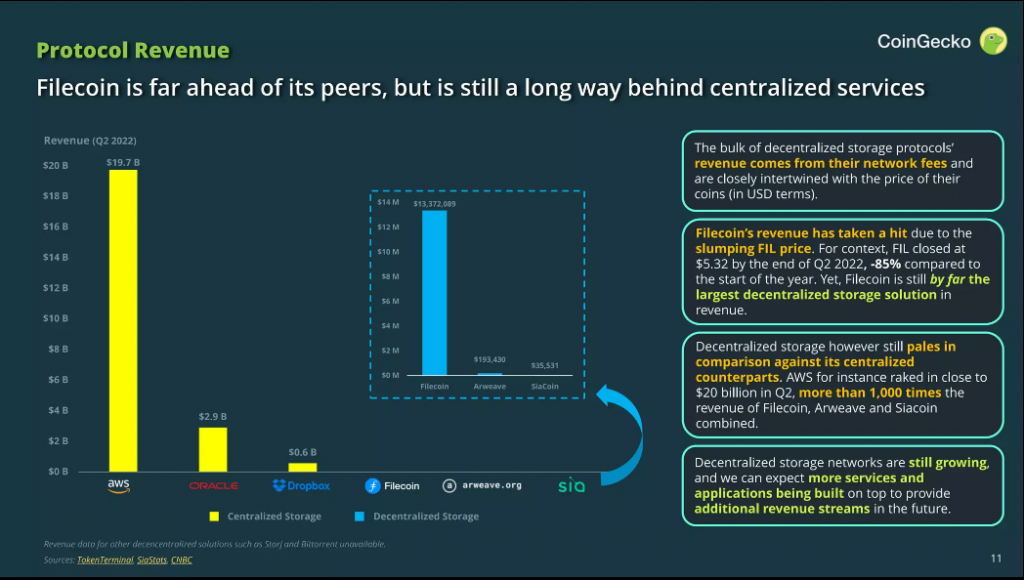
While centralized storage services are not particularly expensive, decentralized protocols are gunning for even lower prices for storage services. For instance, the largest decentralized storage protocol, Filecoin, charges less than a cent per month for a terabyte of storage space. That’s nothing compared with the centralized storage providers, who can charge anywhere from $4.17 to $9.99 a month for a terabyte of storage. However, some storage protocols may charge extra fees for uploading and downloading data from the network.
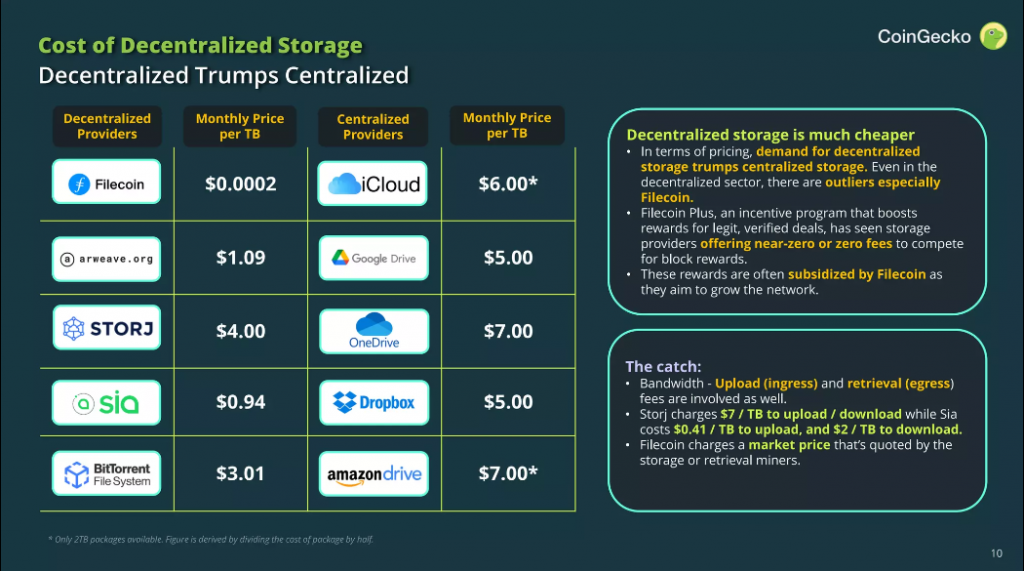
Top Decentralized Storage Protocol Projects
| Project | Token | Market Cap | Annualized Total Revenue | Data Stored |
| Filecoin | FIL | $2,200,000,000 | $39,184,864 | 557241.641 TB |
| Internet Computer | ICP | $1,500,000,000 | N/A | N/A |
| Arweave | AR | $282,100,000 | $89,076 | 138.02 TB |
| Holo | HOT | $346,500,000 | $3,500,000 | N/A |
| SiaCoin | SC | $224,500,000 | $150,360 | 1210 TB |
| Ocean Protocol | OCEAN | $209,200,000 | N/A | N/A |
Investment Thesis
Like in any novel industry, early investors are betting on the future potential of the decentralized storage industry. They see the opportunity for decentralized storage protocols to disrupt the centralized cloud storage industry, which is currently dominated by a few large companies.
If successful, these protocols could see significant adoption and growth, leading to potentially high returns for early investors. On top of believing in the technology, they may view investing in the space as a way of diversifying their portfolio. Here are some of the common ways they are investing:
Investing in cryptocurrencies: Many decentralized storage protocols have their own cryptocurrencies that are used as a means of payment for storage and bandwidth usage. Investors who believe in the potential of the underlying project can buy and hold its tokens, as their success is directly linked.
Mining: Some decentralized storage protocols allow users to sell bandwidth and storage space to the network, to earn rewards in the form of the protocol’s cryptocurrency.
However, there are also potential risks associated with investing in the decentralized storage industry. On top of crypto volatility, there are regulatory risks concerning data compliance, which could impact the value of investments in the decentralized storage space. Also, there’s the question of adoption.
So despite offering potential benefits, such as increased privacy and security, these services may face challenges in gaining widespread adoption and competing with established centralized cloud storage providers.
[embedded content]
Who’s Investing: Institutional Backing
Decentralized storage protocols have been gaining momentum in recent years, with many investors recognizing the potential of this emerging technology. As a result, we have seen a number of notable investments in these projects from big investors.
Filecoin, for instance, raised over $257 million in a token sale in 2017, which was the largest initial coin offering (ICO) at that time. Some notable investors included Sequoia Capital, Andreessen Horowitz, and Union Square Ventures, who collectively raised around $52 million. Another storage protocol, Sia, has raised $3 million over two rounds, and Storj has raised $35.4 million in funding over seven rounds.
Massive tech companies like Microsoft have also shown interest in the space. Recently, through its venture capital fund, it has led a $20 million funding round for Space and Time, a Web3 startup specializing in decentralized data storage.
Top Decentralized Storage Projects
 Filecoin (FIL)
Filecoin (FIL)
The Filecoin network went live in late 2020 and has been one of the most popular and widely-used decentralized storage protocols ever since.
It is an open-source cloud storage network built on the Interplanetary File System (IPFS), a new protocol for the decentralized web, aiming to replace the HTTP protocol. (HTTP identifies data by its location, e.g., the URL where a web page is hosted. IPFS, on the other hand, identifies data by its content, rather than its location.)
Since its launch, Filecoin has allowed users to rent out extra storage space to clients in return for FIL, the platform’s native token. This allows for data to be stored in a trustless manner over their peer-to-peer network.
After its successful ICO and launch, Filecoin has experienced growth in various sectors. In terms of the network’s utilization, Filecoin reported an increase in storage deals (agreements between storage clients and storage providers on the Filecoin network for the provision of storage services) from 699k in January 2020 to over 1 million deals a year later. This number grew to over 16.7M active deals by the end of 2022.
Some of Filecoin’s notable users include Web3 projects like MagicEden and Rarible, and Web2 institutions like UC Berkeley and the City of Philadelphia.
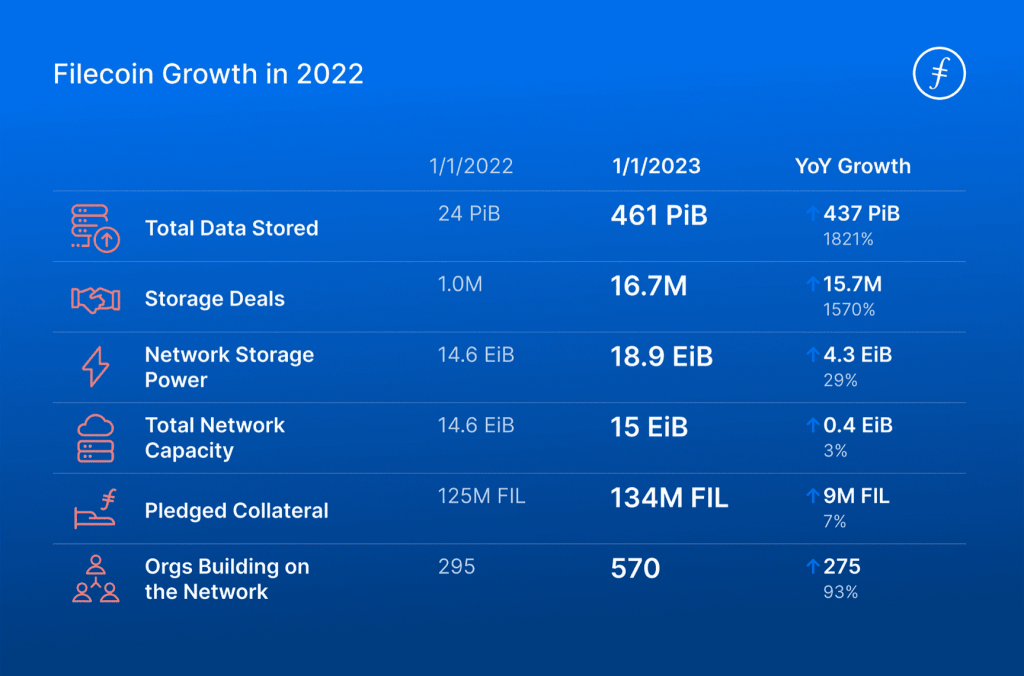
However, Messari reported that Filecoin’s supply-side revenue (revenue generated by storage providers on the Filecoin network for providing client storage service) steadily declined throughout 2022. On the other hand, the protocol’s revenue (revenue generated by the Filecoin network) put up better numbers in the last three quarters of 2022 compared to the first quarter.

Filecoin has held the top position in terms of market capitalization since 2021, so it’s definitely the top project (and token) to watch.
 Internet Computer (ICP)
Internet Computer (ICP)
Internet Computer (ICP) was created by the Dfinity Foundation in 2021 to provide a decentralized, open internet platform that can support smart contracts and other decentralized applications. It lets people build websites and apps not controlled by any central authority by designing them to run on a decentralized network of computers.
The project raised over $190 million in funding and is backed by venture capital firms like Andreessen Horowitz and Polychain Capital. It has experienced tremendous growth since its launch. Currently it sits as the top metaverse blockchain project by market cap ($1.5 billion).
DFINITY reported that new users increased by over 647% (Dec 2021-Dec 2022) from 4,079 to 37,224. ICP’s price, however, has been on a downward trajectory since its launch and has currently settled at around $5.
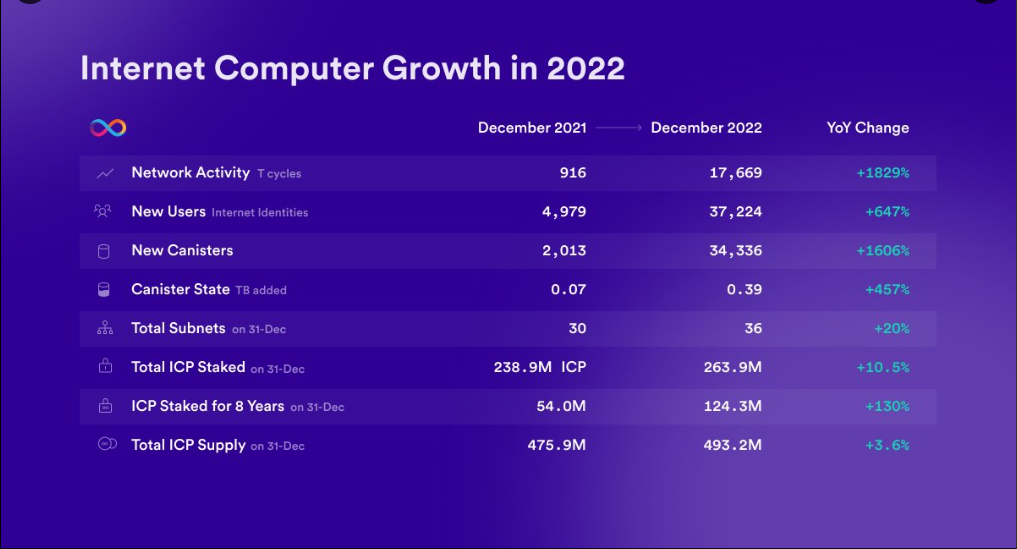
The project has ambitious plans to go toe-to-toe and eventually replace the current centralized web system. They explained in a blog post, “In 10 years’ time, it will be widely recognized by the tech community that the Internet Computer is on a likely trajectory that will one day make it humanity’s primary compute platform for building systems and services, and that the ‘open internet’ will now near-certainly predominate over Big Tech’s closed proprietary ecosystem.”
 Arweave (AR)
Arweave (AR)
Arweave is looking at decentralized file storage from a different perspective. The project is targeting permanent storage, an area unexplored by legacy cloud computing companies. It is attempting to create a new market that allows users to pay a single fee upfront and then be able to store their data forever. So its model is set up to incentivize miners to ensure the permanence, reliability, and availability of the stored data.
Since its mainnet launched in 2018, Arweave did not properly take off until 2021. In that year, the storage protocol recorded growth in revenue throughout the four quarters. During the same period, Arweave recorded up to 7,000 daily active users. These numbers have, however, been dropping throughout 2022, and the protocol has been recording an even lower number of daily active users and revenue in 2023.
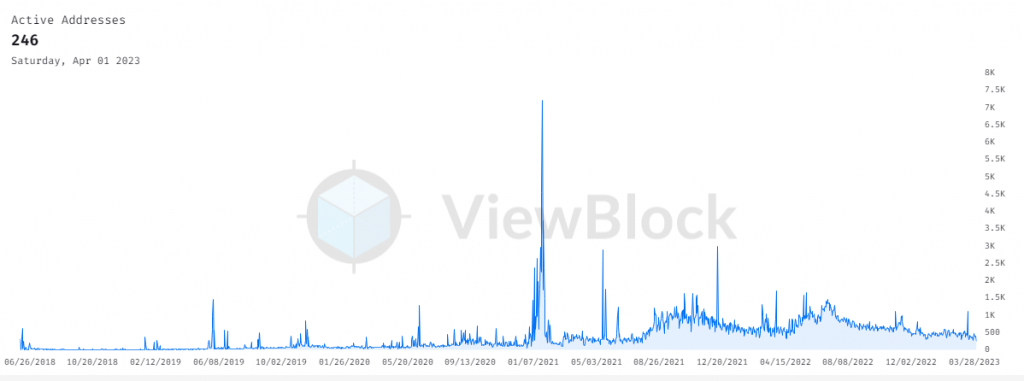
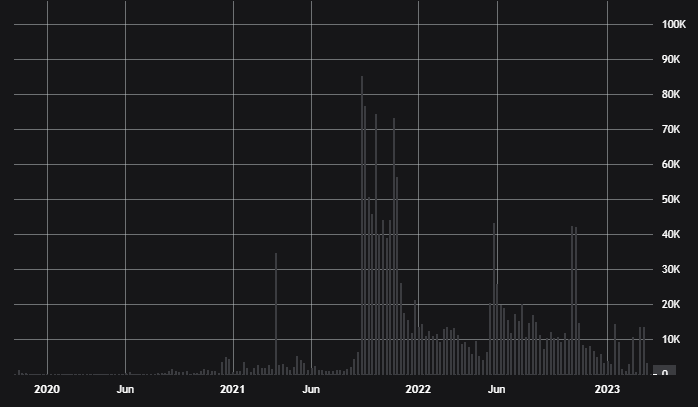
That said, Arweave has still been proactive in its attempt to become the world’s new permanent data storage system, and late last year it announced a partnership with Meta in a tweet, “Happy to announce that Meta is now utilizing Arweave for the storage of their creator’s digital collectibles on Instagram! Bringing data permanence to the giants of Web2!”
 Holo (HOT)
Holo (HOT)
Holo claims to be the “Airbnb of apps,” as it allows users to host and access dapps on a distributed network of computers. By contributing their computing power and bandwidth to the network, they get HoloFuel, a cryptocurrency of the Holo network.
The project raised over $20 million in an ICO but is still in the early testing stages. Despite that, the project has held its position as one of the top 5 decentralized storage projects by market cap in the last two years.

 SiaCoin (SC)
SiaCoin (SC)
Sia is another decentralized storage platform that enables users to rent out their unused storage space to others in exchange for Siacoins, the platform’s native cryptocurrency. On the Siacoin network, files are broken down into smaller pieces, encrypted, and then distributed across multiple hosts to ensure high availability and redundancy, even if one or more hosts go offline.
The project raised over $3 million in funding and, since its launch in 2015, has grown to provide 4,660 TB of storage space, with only 1210 TB of that being used. This number is particularly low, and it gives us an idea of how many people are using the storage service. With little activity on the network, SiaCoin only generates roughly $600 in monthly revenue, down from $12,000 just five months ago.
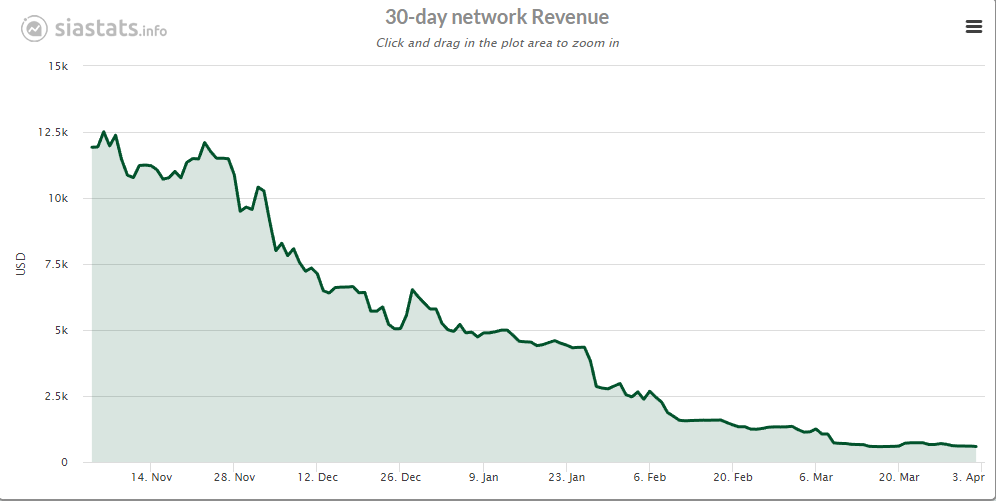
 Ocean Protocol (OCEAN)
Ocean Protocol (OCEAN)
Ocean Protocol is a project mainly focused on monetizing data. It views data as a financial asset. Through the protocol, it can be tokenized into ERC-20 assets known as data tokens that exist on the blockchain. So interested parties (say, data scientists) who benefit from access to more data can buy these data tokens on Ocean’s marketplace.
A report by Messari revealed that Ocean was still struggling with adoption and has notably failed to attract sufficient data providers for its system to work. In a blog post published mid-last year, Messari explained, “The protocol has struggled to attract sufficient data providers. When Ocean originally launched the data tokens, the product launch hype and network rewards garnered high initial traction. Using the number of data token mint transactions and data tokens created as a proxy for traction… Since December 2020, Ocean has had an average of 10–15 mint transactions and ten data tokens created each month.”

The same goes for data token transfers, an important metric since it provides insight into the level of activity in the protocol and interest in buying and selling access to datasets. This number has been generally low, with the protocol recording less than 45 data token transfers per month throughout last year.

Ocean responded to the Messari report, saying, “We knew that building a trillion-dollar Data Economy from the ground up will not be easy. We were first with the NFTs 10 yrs ago, we took learnings into Ocean and we have the conviction that we’re on the right path.”
Despite the performance, Ocean has maintained its position as one of the top storage protocols since 2021.
Investor Takeaway
While decentralized protocols offer many benefits over centralized systems, such as increased security and transparency, they also require a significant shift in mindset and infrastructure to be widely adopted. So one of the biggest hurdles for decentralized protocols may be adoption, as these systems are still relatively new and unfamiliar to many users and businesses.
Regardless, they are a rapidly evolving field, which means that there is significant potential for growth and innovation.
Keep your knowledge of crypto up-to-date by Subscribing to Bitcoin Market Journal.
- SEO Powered Content & PR Distribution. Get Amplified Today.
- Platoblockchain. Web3 Metaverse Intelligence. Knowledge Amplified. Access Here.
- Source: https://www.bitcoinmarketjournal.com/sector-report-decentralized-storage-protocols/



